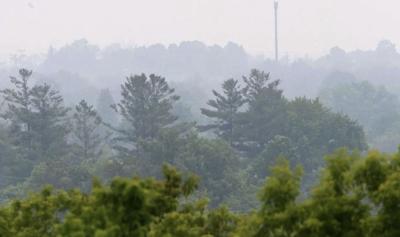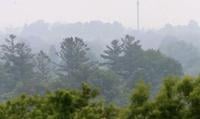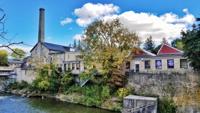Canada had some of the worst air quality in North America on Tuesday morning according to , the website for the World Air Quality Index project.
Wildfires across the prairies and in northern Ontario are impacting air quality, generating concerns for anyone with asthma or underlying health issues.
World Air Quality Index
The World Air Quality Index project uses measurements of particulate matter, including PM 2.5, which are 2.5 microns or smaller, as well as ozone, nitrogen oxide, sulphur dioxide and carbon monoxide emissions.
Canada had an overall air quality rating of 154 on Tuesday morning, which is considered ‚Äúunhealthy.‚ÄĚ
Saskatoon, Saskatchewan had the worst air in the country, according to , with a reading of 223 as of 11 a.m., which is considered ‚Äúvery unhealthy.‚ÄĚ
The province has been heavily impacted by wildfire smoke, including last weekend, when a Canadian Football League game in Regina between the Saskatchewan Roughriders and Calgary Stampeders was postponed from Friday to Saturday due to poor air quality.
‘Unhealthy’ ratings in Ontario
On July 15, Toronto had a ¬†rating of 122, which is ‚Äúunhealthy for sensitive groups.‚ÄĚ Milton and Hamilton both had ratings of 132. Galetta, a community in rural western Ottawa, had Ontario‚Äôs worst air quality with a rating of 152 on Tuesday.
Heat alert continues
Ontario is also grappling with a on Tuesday, with a warning from Environment Canada of a ‚Äúprolonged period of extreme heat and humidity.‚ÄĚ
can expect a daytime high of 31 C on Tuesday and even higher temperatures for Wednesday, with a high of 33 C.
Meanwhile, Environment Canada issued a for southern Ontario on Tuesday, ‚Äúdue to the possibility of deteriorating air quality.‚ÄĚ The alert covers Windsor, Toronto, York Region, Mississauga, Brampton, Halton Hills, Burlington and St. Catharines.
According to , most of Ontario returned to a ‚Äúmoderate‚ÄĚ air quality risk on Tuesday, with air quality health index readings in the four to six range. Readings of eight and above are considered ‚Äúhigh risk‚ÄĚ or ‚Äúvery high risk.‚ÄĚ Conditions have improved from Monday, when Toronto and parts of southern Ontario saw ratings in the 10 or 10+ range, indicating a ‚Äúvery high risk.‚ÄĚ
Special air quality statement
‚ÄúElevated pollution levels are expected today,‚ÄĚ Environment Canada warned in Tuesday‚Äôs special air quality statement.
‚ÄúWeather conditions are expected to cause increasing levels of ozone,‚ÄĚ Environment Canada added.
Moderate risk air quality health index (AQHI) values are expected on Tuesday with the potential for short-term high risk AQHI values due to ozone combining with residual wildfire smoke, the weather agency said.
What to do
When air pollution levels are high, residents of affected areas should limit time outdoors and consider reducing or rescheduling outdoor sports, activities and events, Environment Canada said in Tuesday’s advisory.
During periods of poor air quality, Canadians may experience symptoms such as eye, nose and throat irritation, headaches or a mild cough. More serious but less common symptoms include wheezing, chest pains or severe cough, Environment Canada added.
Adults aged 65 and older, pregnant people, infants and young children, people with an existing illness or chronic health condition, and people who work outdoors, should reduce or reschedule strenuous activities outdoors and seek medical attention if experiencing symptoms.
When indoors, residents should keep windows and doors closed as much as possible and prioritize keeping cool during heat events.
To protect your indoor air from outdoor air pollution, use an air filter in your ventilation system or a certified portable air cleaner.
Should you wear a mask?
In a , Dr. Kevan Mehta, a pediatric respirologist at McMaster Children’s Hospital in Hamilton, said fine particles known as PM 2.5 can impact the lungs and other systems of the body.
Families may choose to stay indoors during air quality advisories, but Mehta recommends a balanced approach. With hot and humid air conditions, anyone with breathing issues should weigh health and safety considerations when planning outdoor activities.
If you have a chronic breathing issue such as asthma, an N95 mask can filter out PM 2.5 irritants. Lower-grade masks may offer protection from larger particles, but they won’t filter out PM 2.5.
But given how difficult it can be to breathe in hot, humid air, Mehta doesn’t recommend using an N95 mask for an extended time outdoors, especially for children.
Error! Sorry, there was an error processing your request.
There was a problem with the recaptcha. Please try again.
You may unsubscribe at any time. By signing up, you agree to our and . This site is protected by reCAPTCHA and the Google and apply.
Want more of the latest from us? Sign up for more at our newsletter page.





















To join the conversation set a first and last name in your user profile.
Sign in or register for free to join the Conversation